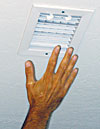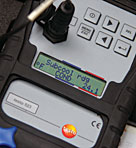
Flow hoods can yield good results, but they are expensive compared to other technician's tools such as digital power multimeters or refrigerant gauges. As a result, very few technicians routinely carry flow hoods on their trucks. Using a manometer to derive velocity pressure and then calculating cubic feet per minute (cfm) can be time consuming, as can measuring airflow using the heat pump strip method - and not everyone has a heat pump.
If the tools aren't readily available and the spirit isn't willing, it is common for residential technicians to resort to using their hands to estimate airflow, which is clearly not an acceptable, or scientific, method.
A possible solution may rest with the grille and register manufacturers, who could potentially make a technician's life easier by labeling products with their name, model number, and net free square feet (NFSF), or Ak. Manufacturers contend that this information is readily available in their catalogs and on their Websites and that adding this labeling would push the product costs higher. Not to mention that labeling could ruin the overall look of the grille or register.
While the blame for improper airflow in a system could be placed at the feet of any one of a number of different entities, the bottom line is that the one who did the least to create the problem is the one who suffers the most: The homeowner.
GO WITH THE FLOW
Airflow is the most enigmatic part of a heating or cooling system, yet it is probably the one component that causes the most trouble. Too much airflow can cause reduced temperature rise in the furnace heat exchanger, reduced moisture removal in cooling mode, and increased duct leakage. Too little airflow can cause possible damage to the furnace heat exchanger, possible damage to the compressor from the return of liquid refrigerant, and increased air handler/supply trunk sweating.Studies by Lawrence Berkeley National Laboratory (LBNL) have shown that forced-air systems have the potential for significant energy losses because of air leaks and their installation outside the heated and cooled parts of the house. Recent research performed by LBNL found that typically a quarter of the energy (and therefore money) used for heating and cooling is wasted through duct system energy losses.
The California Institute for Energy and Environment (CIEE), which works closely with LBNL, noted that because duct systems lose energy that is supposed to heat or cool the house, they change the effective capacity of heating and cooling equipment. For example, a three-ton air conditioner connected to a duct system of 75 percent efficiency effectively becomes a two-and-a-quarter ton air conditioner. Meanwhile, the unit still consumes all the electricity required for three tons of cooling.

Which brings us back to the question: How can a technician quickly approximate how much airflow is coming out of a register or how much air is a system moving? The answer, according to Jim Herritage, CEM, president, Energy Auditors Inc., Mount Pleasant, S.C., is for grille and register manufacturers to develop uniform product labeling standards.
"Every grille and register should be labeled with its NFSF, or Ak," said Herritage. "Then, by using a relatively inexpensive airflow meter, technicians could measure face velocity in feet per minute and simply multiply that number times the listed ‘net free' square foot area for the grille or register to estimate cfm. It could be done within one or two minutes."
Ray Gatt, vice-president sales and marketing, Decor Grates, Toronto, stated that labeling a grille will still not rectify the problem in the long run. "If a technician goes to a home and it has a poorly installed or undersized duct system, no amount of labeling on grilles or registers will correct the problem."

INFORMATION READILY AVAILABLE
Dave Fetters, technical services manager, Hart & Cooley, Holland, Mich., stated that labeling is an unnecessary step, because the Ak factors for all his company's models are readily available in the performance data section of its catalog. As for unlisted sizes, Ak factors for equivalent sizes of the same model are close enough to use, said Fetters, or a customer is welcome to call for help.Herritage argued that simply publishing the Ak factors in a catalog is not sufficient for technicians for several reasons. "First, most return grilles in use today are not even labeled as to who the manufacturer is, let alone which model it is. Second, technicians don't have the time to go tracking that kind of stuff down on routine service calls. If it's not there in front of them, on the device, it's useless for routine service work."
Fetters added that product cost drives a purchase decision more than performance these days. "Adding a label with the Ak factor would be relatively expensive and an added cost we are not willing to absorb," he said.

Herritage disagreed with these statements, too, saying that using expense as a reason for not labeling is a smoke screen. "Look at any inexpensive desk lamp, telephone, or computer mouse, and it's labeled. Labeling does not have to be big - just look on the back of your watch."
Labeling doesn't have to be unsightly either, added Herritage, as it could be printed on the inside of return grilles, which is out of sight to the homeowner. On supply registers, the information could be printed in visible, but not highly contrasting colors, such as gray on a white register or dark gray on a silver register.

Fetters agreed that technicians don't always take the time to carefully measure airflow. "The key to any airflow measurement is to arrive at a good average face velocity using an adequate instrument," said Fetters. "A good average velocity is achieved with many readings covering the entire area in small increments. That average velocity is then multiplied times the effective area to calculate cubic feet per minute. The math is simple, the technique is easy, and the data is available."
Indeed, it is simple, said Gatt, especially if technicians are already doing the heat rise calculations on the furnace. "These calculations have to be done anyway to certify the furnace and eliminate the technician from liability. Once they do that, they can take the cfm rating then set up the rest of the house," added Gatt.

The debate could continue forever, with both sides offering up facts and opinions to bolster their side of the argument. The fact remains, however, that many researchers have determined that too many homes do not have proper airflow, which makes the homeowner the ultimate loser.
Publication date: 07/24/2006




